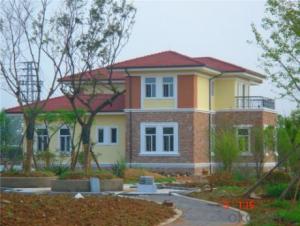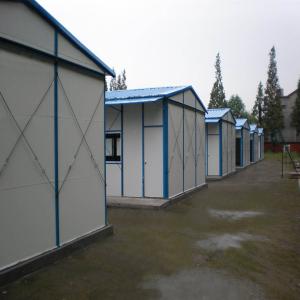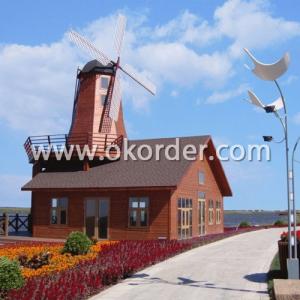Light steel prefab villa
- Loading Port:
- China Main Port
- Payment Terms:
- TT OR LC
- Min Order Qty:
- -
- Supply Capability:
- -
OKorder Service Pledge
Quality Product, Order Online Tracking, Timely Delivery
OKorder Financial Service
Credit Rating, Credit Services, Credit Purchasing
You Might Also Like
The adavantages of the light gauge steel villa:
1. Better thermal insulation
The advanced exterior overall thermal insulation meets the updated state energy-saving standards for buildings. It refrains from the cold and thermal bridges phenomenon, and keeps buildings away from damages such as dampness, distortion, mildew and corrosion.
The unique heat reflection and ventilation layer design can make better insulation effects. Temperature can be reduced by five to eight degrees. ( In my opinion, this advantage is very suitable for the climatic condition of Middle East )
2. Seismic and Wind Resistance
Withstand the shock of 9 on the Richter scale. The dense light gauge steel and column are connected in flexible method with screws and bolts, which can abosorb the energy of eathquake. There are fittings between foundation and wall, which are resistant to pull out and shear. The total weight of the house is light, which is only 1/6 of the conventional concrete houses. Therefore it has better anti-seismic performance.
Can endure typhoon of 12 levels
There are special fittings among roof, floor, wall and foundation. The strong connection can help resist typhoon of 12 levels.
3. Roof Load-bearing and Fireproof
The structure can be designed according to climate requirements.
Wall and floor slab use special technology which can meet 3h refractory limit.
4. Sound insulation
Improved technology on sound insulation and shock absorption meet the state building standards for sound insulation. Special methods are performed, especially towards the audio frequency ranging from 250-1000Hz which is the most sensitive to ears, in order to create a quiet and comfortable living environment.
5. Moisture-proof and Ventilation
There is a gap between wall and roof truss, so the air can flow inside.
There is one-way ventilation layer in the composite wall, which is able to make the wall "breath". This means moisture can be reduced inside the door.
6. Durable (90 years structure safty guarantee)
Special coating technology enables the structural materials to have the self-restoration function to prevent rust and corrosion.
Envelope materials using new light weight building materials to achieve fire resistant, anti-corrosion and anto-moth.
7. Energy Efficient and Enviromental Protection
Energy Saving: 65-90 energy redution.
Water Saving: The dry construction consumes 10% of water used in traditional constrution.
Land Saving: The inside usable area increases 10%
Environment Protection: Pollution-free construction system.
- Q:Can container houses be connected to municipal utilities?
- Yes, container houses can be connected to municipal utilities. While container houses are typically built from repurposed shipping containers, they can still be equipped with the necessary infrastructure to connect to municipal utilities such as water, electricity, and sewer systems. The process of connecting a container house to these utilities may require some additional planning and modifications, but it is definitely possible. Many container house designs incorporate plumbing and electrical systems that can be connected to the local water and power grids. Additionally, container houses can be equipped with septic tanks or connected to the municipal sewer lines for waste disposal. It is important to consult with local authorities and utility providers to ensure that all necessary permits and regulations are met when connecting a container house to municipal utilities.
- Q:Can container houses be designed to be wheelchair accessible?
- Indeed, it is possible to create container houses that are wheelchair accessible. Customization and careful design can ensure that the needs of wheelchair users are met. There are various modifications that can be implemented to achieve wheelchair accessibility in container houses. To start, modifications can be made to the entry points of the container house. Instead of stairs, ramps or lifts can be installed to allow easy entry and exit for wheelchair users. Furthermore, the width of the entry points can be expanded to accommodate wider wheelchairs. Additionally, the interior layout can be tailored to facilitate wheelchair maneuverability. Wider doorways and hallways can be incorporated to allow for easy navigation. By replacing doors with wider ones and widening the hallways, wheelchair accessibility standards can be met. Furthermore, the flooring can be made smooth and even, providing a comfortable and accessible surface for wheelchair users. Moreover, the bathroom and kitchen areas can be designed with wheelchair accessibility in mind. Lower countertops and sinks can be installed, along with grab bars and handrails for added support and stability. Showers can be designed with roll-in access and seating options for wheelchair users. Furthermore, an open floor plan can be adopted to create ample space for wheelchair users to move around freely. Furniture and fixtures can also be chosen or adjusted to be wheelchair-friendly, taking into account height and accessibility. In conclusion, it is certainly possible to design container houses that are wheelchair accessible. By carefully planning and customizing the design, a comfortable and accessible living space can be created for wheelchair users.
- Q:Recruitment of warehouse staff and warehouse manager of the quality requirements?
- have a good professionalism, motivated, flexible response, work seriously responsible
- Q:Are container houses structurally sound?
- Indeed, container houses boast remarkable structural stability. Engineered to endure harsh weather conditions and the demands of being stacked upon one another during transit, shipping containers are crafted from robust high-strength steel. Remarkably, even after being transformed into homes, their structural integrity remains intact. Furthermore, it is possible to reinforce container houses with supplementary support beams or weld them together to fashion more expansive living areas. Given the appropriate engineering and construction measures, container houses can effortlessly meet or surpass the structural criteria set for conventional homes.
- Q:What types of container houses are available?
- There are various types of container houses available, including single-unit designs, multiple-container configurations, and even stacked container homes. Some container houses feature open floor plans, while others have divided spaces for specific purposes such as bedrooms, bathrooms, and kitchens. Additionally, there are container homes designed for off-grid living, with solar panels and water collection systems. Ultimately, the options for container houses are diverse and can be customized to meet individual preferences and needs.
- Q:Are container houses suitable for outdoor adventure or glamping accommodations?
- Container houses are an ideal option for outdoor adventure or glamping accommodations. They are versatile and can be easily transported to remote locations, making them a great choice for outdoor enthusiasts. Moreover, they offer a distinctive and environmentally-friendly alternative to traditional structures, providing a comfortable living space for those who love the outdoors. Customization is another advantage of container houses. They can be tailored to meet specific needs and preferences, allowing for a harmonious blend of nature and modern amenities. With proper insulation, ventilation, and plumbing systems, container houses can provide a cozy environment even in extreme weather conditions. Additionally, their sturdy construction ensures durability and resistance to natural elements, making them suitable for various outdoor settings. Furthermore, container houses can be designed with large windows and open floor plans, maximizing natural light and offering breathtaking views. This creates a strong connection with the surrounding environment, enhancing the overall outdoor adventure or glamping experience. Additionally, they can be equipped with innovative features such as solar panels, rainwater harvesting systems, and composting toilets, further enhancing their sustainability and eco-friendly appeal. In conclusion, container houses are an excellent choice for outdoor adventure or glamping accommodations. They offer versatility, durability, and sustainability, providing a comfortable and unique living space that seamlessly integrates with the natural surroundings. Whether for a short weekend getaway or a long-term stay, container houses can create a memorable and enjoyable outdoor experience.
- Q:What is a simple container?
- Container container (container simple room), also known as container room, container housing, container housing, refers to the main container-based material slightly modified into a window with a house
- Q:Are container houses resistant to natural disasters?
- The level of resilience of container houses in the face of natural disasters depends on various factors. They have a main advantage in their structural strength, as they are constructed using sturdy steel containers that can withstand rough handling during transportation. This strength makes them resistant to certain natural disasters like earthquakes and high winds. Container houses also possess fire resistance due to the high melting point of the steel material used in their construction. This feature is particularly beneficial in areas prone to wildfires or accidental fires. However, container houses may not be as resistant to other types of natural disasters, such as flooding. This is because they are typically placed on a foundation close to the ground. In areas with a high risk of hurricanes or extreme weather conditions, additional reinforcements and modifications may be necessary to ensure the safety of the house. Moreover, the quality of construction and the expertise of the builders play a significant role in determining the level of resistance to natural disasters. Proper planning, engineering, and adherence to building codes and regulations are crucial to maximize the resilience of container houses. In conclusion, while container houses can offer some resistance to certain natural disasters, it is essential to consider the specific risks and requirements of the location. Seeking advice from professionals and implementing appropriate measures can enhance the safety and resilience of container houses in the face of natural disasters.
- Q:Can container houses be designed with wheelchair accessibility?
- Yes, container houses can be designed with wheelchair accessibility. While container houses are typically smaller in size compared to traditional houses, they can still be modified to accommodate wheelchair users. To ensure wheelchair accessibility, several design considerations can be implemented. Firstly, the entrance to the container house can be modified to include a ramp or a wheelchair lift. This allows wheelchair users to easily enter and exit the house without any barriers. Furthermore, the interior layout can be designed to be spacious and open, allowing for easy maneuverability for wheelchair users. Wider doorways and hallways can be incorporated to ensure easy passage. Additionally, the installation of grab bars and handrails in appropriate areas can provide additional support and safety. Other modifications can also be made to accommodate wheelchair users, such as lowering countertops and cabinets to a suitable height, ensuring that light switches and electrical outlets are within reach, and incorporating roll-in showers or accessible bathrooms. While container houses may present some challenges due to their smaller size, creative design solutions can be implemented to make them wheelchair accessible. With careful planning and consideration, container houses can provide a comfortable and accessible living environment for wheelchair users.
- Q:Can container houses be designed with hurricane-resistant features?
- Yes, container houses can be designed with hurricane-resistant features. While shipping containers are inherently strong and durable, additional measures can be taken to ensure their ability to withstand hurricane forces. One key aspect of designing a hurricane-resistant container house is reinforcing the structure to resist strong winds. This can involve strengthening the container walls, roof, and floor by adding additional steel beams or braces. By reinforcing the container, it becomes better equipped to handle the high wind pressures during a hurricane. Another important aspect is securing the container house to its foundation. This can be achieved by using strong anchor systems such as concrete footings or helical piles. Properly anchoring the container house will prevent it from being lifted or moved by strong winds, reducing the risk of structural damage. In addition, designing the container house with hurricane-resistant windows and doors is crucial. Impact-resistant windows and doors, made from materials like laminated glass or polycarbonate, can withstand flying debris and pressure differentials caused by hurricanes. These features ensure that the container house remains intact and keeps its occupants safe during a storm. Furthermore, proper insulation and ventilation systems should be integrated into the container house to prevent water infiltration during heavy rainfall associated with hurricanes. Adequate waterproofing measures combined with proper drainage systems will help to mitigate the risk of flooding or water damage. It is important to note that while container houses can be designed with hurricane-resistant features, no structure can be completely hurricane-proof. The severity of a hurricane and its impact on a container house will depend on various factors such as its location, the strength of the storm, and the quality of construction. However, incorporating hurricane-resistant design features greatly enhances the chances of the container house withstanding the forces of a hurricane and protecting its occupants.
1. Manufacturer Overview |
|
|---|---|
| Location | |
| Year Established | |
| Annual Output Value | |
| Main Markets | |
| Company Certifications | |
2. Manufacturer Certificates |
|
|---|---|
| a) Certification Name | |
| Range | |
| Reference | |
| Validity Period | |
3. Manufacturer Capability |
|
|---|---|
| a)Trade Capacity | |
| Nearest Port | |
| Export Percentage | |
| No.of Employees in Trade Department | |
| Language Spoken: | |
| b)Factory Information | |
| Factory Size: | |
| No. of Production Lines | |
| Contract Manufacturing | |
| Product Price Range | |
Send your message to us
Light steel prefab villa
- Loading Port:
- China Main Port
- Payment Terms:
- TT OR LC
- Min Order Qty:
- -
- Supply Capability:
- -
OKorder Service Pledge
Quality Product, Order Online Tracking, Timely Delivery
OKorder Financial Service
Credit Rating, Credit Services, Credit Purchasing
Similar products
New products
Hot products
Related keywords





























